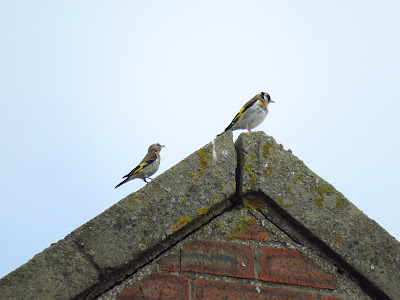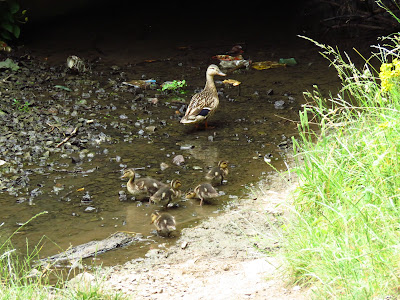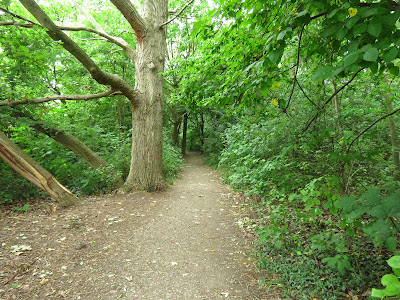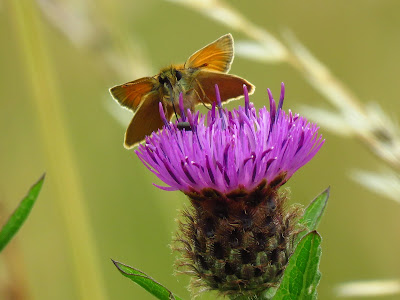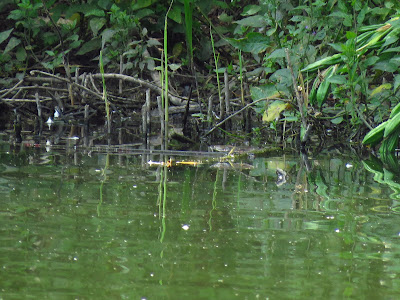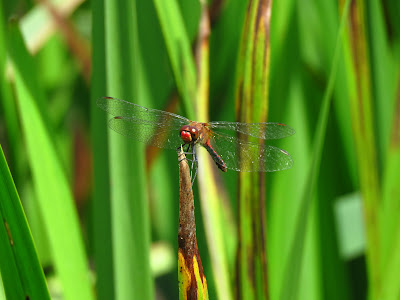I took the bus to Kingswood Asda and started my walk there. A very hot sunny day, I felt a trip to Foredyke Green Pond and Noddle Hill to do dragonfly surveys was overdue. First, I walked through Wilberforce Wood/Midmeredales area. The woodland felt lovely and cool, and the rides and grassland were teeming with butterflies.

Chiffchaffs, Blackcaps and a Whitethroat sung. I was slowed down by checking Small Skippers, but there were no surprises today.
Speckled Wood.
Small Skipper on Creeping Thistle.
Small Skipper on Great Knapweed. There were several patches of this plant, combined with Lady's Bedstraw.
Small Skipper and Leafcutter on thistle.
A ride as it crosses a ditch.
Meadow Brown.
The Midmeredales pond had low water levels in early June but now it was completely dry.
Foredyke Green Pond
I anticipated visiting the Foredyke Green pond. I've had some wonderful sightings there, what would expect me today? There!
A Broad-bodied Chaser male! just when I thought I had missed them for the year! The pristine male was mostly sitting on the rushes and avoiding the resident Emperor. The effect of its very reflective pruinosity made it look like a beacon when it flew, favouring the side of the pond with short rushes. The pond today had a lot of Potamogeton cover. A Brown Hawker was also patrolling.
Damselflies included Blue-tailed Damselfly, with several colour morphs and a mating pair. There were also ovipositing Azure Damselfly.
Azure Damselfly.
Mating Blue-tailed Damselflies. Note the female is the androchrome form that has the same colours as male.
Common Darter, the only one I saw today.
The violacea form of female Blue-tailed Damselfly, stunning!
Male Ruddy Darter.
A Willow emerald flew around the apple tree over the bench, I had a clear look at the body proportions and colour, there was no mistaken it! Unfortunately it flew right under and inside the tree disappearing from view. They have been very early everywhere this year.

Brimstone.
Noddle Hill LNR
I had planned originally to walk along the Foredyke Stream to the pumping station, but the path hadn't been mowed and it has hard going with the heat now draining my energy quite fast, so half-way through I moved into the reserve. On the way I flushed a number of Brown Hawkers from the streamside vegetation. Birds were quite subdued, possibly due to the heat and the fact that is wasn't very early, so I headed for the lake and pond-dipping pond to check for dragonflies.
The main character of the day were Black-tailed Skimmers, males on their fishing platforms and marginal vegetation, with much chasing.
The number 14 Black-tailed Skimmer.
Female Black-tailed Skimmer egg-laying.
The distinctive egg sacs of Tetragnatha spiders.
A record shot of a pair of Black-tailed Skimmers mating, subsequently, the females started laying.
After checking the lake shores for a while I moved onto the ditch that is the best for Emerald in the whole of Hull. Water levels were very low, I had to walk though the reeds for a couple of meters, but I was rapidly rewarded by a male Emerald Damselfly, which darted to chase another male and then both disappeared from view. Two Ruddy Darters were also by the ditch.
Male Emerald Damselfly.
Ruddy Darter.
Most damselflies were Common Blue.
An uncooperative terrapin in the pond-dipping pond. A local told me two had been seen in this pond and one on the main lake.
I had to take a rest in the shade so I had an early lunch on the picnic tables by the feeding station. Shortly after a young Robin paid a visit and was happy to get quite close to get some walnut bits.
Young Robin.
















